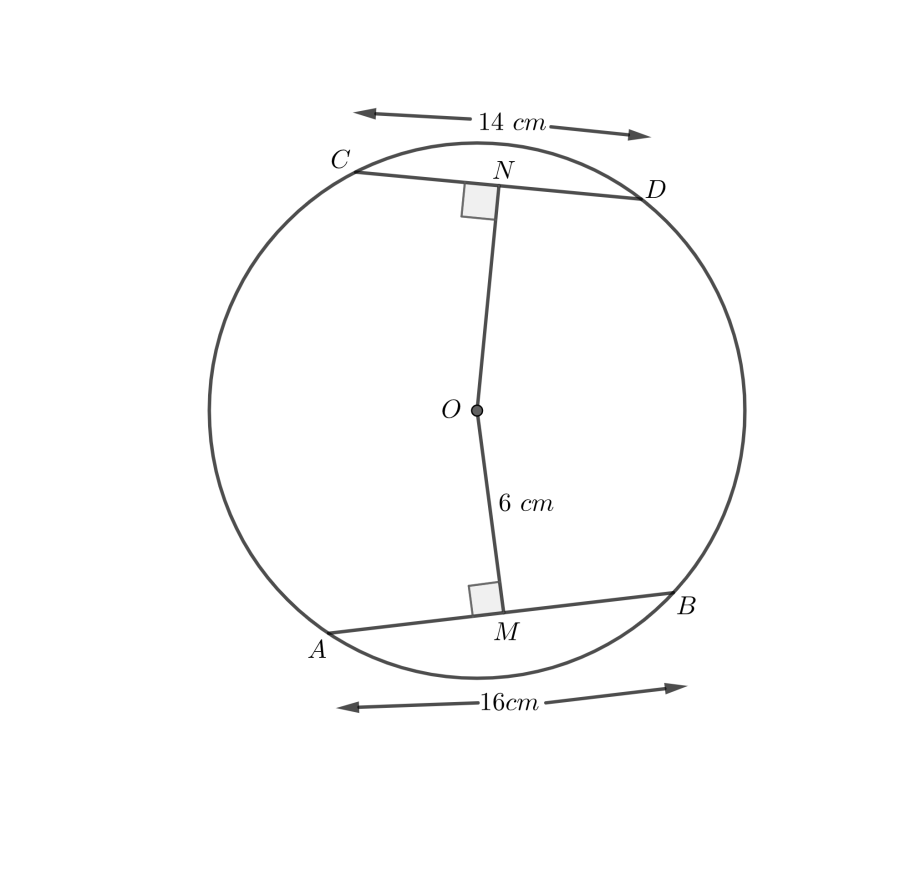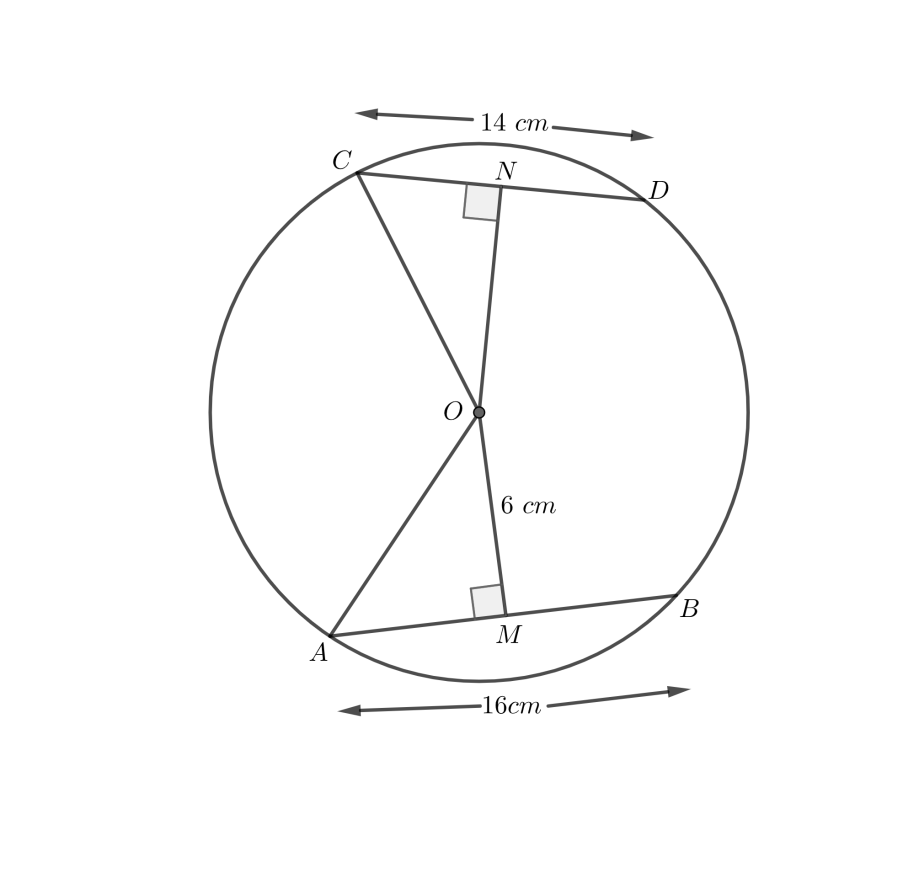
In the given figure, $O$ is the centre of a circle and it is given that $AB=16\text{ cm}$, $CD=14\text{ cm}$ , and the segment $OM$ is perpendicular to the segment $AB$ and the segment $ON$ is perpendicular to the segment $CD$. The length of the segment is $OM=6\text{ cm}$. Now, it is given that the length of the segment $ON$ is $\sqrt{m}\text{ cm}$ . So, find the value of $m$.

A. $m=149\text{ c}{{\text{m}}^{2}}$
B. $m=51\text{ c}{{\text{m}}^{2}}$
C. $m=51\text{ cm}$
D. $m=149\text{ cm}$

Answer
550.2k+ views
Hint: Start by joining the segments $OC\text{ and }OA$ then we will find the length of $AM\text{ and }CN$ by applying the theorem that if a perpendicular line is drawn from the centre of the circle on the chord of the circle then it bisects the chord then we will apply the Pythagoras theorem that is ${{\left( \text{Hypotenuse} \right)}^{\text{2}}}={{\left( \text{Perpendicular} \right)}^{\text{2}}}+{{\left( \text{Base} \right)}^{2}}$ in triangles $\Delta AOM$ and $\Delta CON$and hence, get the answer.
Complete step by step answer:
Now, we are given in the question that:
$AB=16\text{ cm}$, $CD=14\text{ cm}$, $OM\bot AB$ and $OM=6\text{ cm}$ and $ON\bot CD$ .
Now we have to find the value of $m$so we will find the length of the segment $ON$.
First of all we will join $OC\text{ and }OA$ and get the following figure:

As, we can see from the figure that $AB\text{ and }CD$ are the chords of the circle.
Now, we know that if a perpendicular line is drawn from the centre of the circle on the chord of the circle then it bisects the chord.
Therefore, \[\]
$\Rightarrow AB=2AM\Rightarrow AM=MB=\dfrac{AB}{2}\Rightarrow AM=MB=8\text{ cm}$
$\Rightarrow CD=2CN\Rightarrow CN=ND=\dfrac{CD}{2}\Rightarrow CN=ND=7\text{ cm}$
Now, we know that $\Delta AOM$ is a right angled triangle as it is given that , $OM\bot AB$, we will now apply the Pythagoras theorem on this triangle that is: ${{\left( \text{Hypotenuse} \right)}^{\text{2}}}={{\left( \text{Perpendicular} \right)}^{\text{2}}}+{{\left( \text{Base} \right)}^{2}}$
Therefore,
$\begin{align}
& \Rightarrow O{{A}^{2}}=O{{M}^{2}}+M{{A}^{2}} \\
& \Rightarrow O{{A}^{2}}={{6}^{2}}+{{8}^{2}}\Rightarrow O{{A}^{2}}=36+64\Rightarrow O{{A}^{2}}=100 \\
& \Rightarrow OA=\sqrt{100} \\
& \Rightarrow OA=10\text{ cm} \\
\end{align}$
Similarly, $\Delta CON$ is a right angled triangle as it is given that , $ON\bot CD$, we will now apply the Pythagoras theorem on this triangle
$\Rightarrow O{{C}^{2}}=O{{N}^{2}}+C{{N}^{2}}$
Now, we know that $OA=OC=10\text{ cm}$ , as both are radius of the circle.
Therefore,
$\begin{align}
& \Rightarrow O{{C}^{2}}=O{{N}^{2}}+C{{N}^{2}} \\
& \Rightarrow {{10}^{2}}=O{{N}^{2}}+{{7}^{2}}\Rightarrow O{{N}^{2}}=100-49\Rightarrow O{{N}^{2}}=51 \\
& \Rightarrow ON=\sqrt{51}\text{ cm} \\
\end{align}$
Now, in the question in is given that $ON=\sqrt{m}\text{ cm }\Rightarrow \sqrt{m}\text{ cm}=\sqrt{51}\text{ cm}$
So, the correct answer is “Option C”.
Note: For these types of questions you must know the properties and theorems of circles and chords, in this way the solution becomes easy. Students may make mistakes while applying the Pythagoras theorem as it involves squaring of numbers. Remember the square of a number $n$ is ${{n}^{2}}=n\times n$
Complete step by step answer:
Now, we are given in the question that:
$AB=16\text{ cm}$, $CD=14\text{ cm}$, $OM\bot AB$ and $OM=6\text{ cm}$ and $ON\bot CD$ .
Now we have to find the value of $m$so we will find the length of the segment $ON$.
First of all we will join $OC\text{ and }OA$ and get the following figure:

As, we can see from the figure that $AB\text{ and }CD$ are the chords of the circle.
Now, we know that if a perpendicular line is drawn from the centre of the circle on the chord of the circle then it bisects the chord.
Therefore, \[\]
$\Rightarrow AB=2AM\Rightarrow AM=MB=\dfrac{AB}{2}\Rightarrow AM=MB=8\text{ cm}$
$\Rightarrow CD=2CN\Rightarrow CN=ND=\dfrac{CD}{2}\Rightarrow CN=ND=7\text{ cm}$
Now, we know that $\Delta AOM$ is a right angled triangle as it is given that , $OM\bot AB$, we will now apply the Pythagoras theorem on this triangle that is: ${{\left( \text{Hypotenuse} \right)}^{\text{2}}}={{\left( \text{Perpendicular} \right)}^{\text{2}}}+{{\left( \text{Base} \right)}^{2}}$
Therefore,
$\begin{align}
& \Rightarrow O{{A}^{2}}=O{{M}^{2}}+M{{A}^{2}} \\
& \Rightarrow O{{A}^{2}}={{6}^{2}}+{{8}^{2}}\Rightarrow O{{A}^{2}}=36+64\Rightarrow O{{A}^{2}}=100 \\
& \Rightarrow OA=\sqrt{100} \\
& \Rightarrow OA=10\text{ cm} \\
\end{align}$
Similarly, $\Delta CON$ is a right angled triangle as it is given that , $ON\bot CD$, we will now apply the Pythagoras theorem on this triangle
$\Rightarrow O{{C}^{2}}=O{{N}^{2}}+C{{N}^{2}}$
Now, we know that $OA=OC=10\text{ cm}$ , as both are radius of the circle.
Therefore,
$\begin{align}
& \Rightarrow O{{C}^{2}}=O{{N}^{2}}+C{{N}^{2}} \\
& \Rightarrow {{10}^{2}}=O{{N}^{2}}+{{7}^{2}}\Rightarrow O{{N}^{2}}=100-49\Rightarrow O{{N}^{2}}=51 \\
& \Rightarrow ON=\sqrt{51}\text{ cm} \\
\end{align}$
Now, in the question in is given that $ON=\sqrt{m}\text{ cm }\Rightarrow \sqrt{m}\text{ cm}=\sqrt{51}\text{ cm}$
So, the correct answer is “Option C”.
Note: For these types of questions you must know the properties and theorems of circles and chords, in this way the solution becomes easy. Students may make mistakes while applying the Pythagoras theorem as it involves squaring of numbers. Remember the square of a number $n$ is ${{n}^{2}}=n\times n$
Recently Updated Pages
How do you convert r6sec theta into Cartesian form class 10 maths CBSE

How do you solve dfrac5y3dfracy+72y6+1 and find any class 10 maths CBSE

If sin A+B1 and cos AB1 0circ le left A+B rightle 90circ class 10 maths CBSE

On the number line 10 is to the of zero class 10 maths CBSE

How do you solve 5xge 30 class 10 maths CBSE

In the following sentence supply a verb in agreement class 10 english CBSE

Trending doubts
Write an application to the principal requesting five class 10 english CBSE

Why is there a time difference of about 5 hours between class 10 social science CBSE

Write a letter to the principal requesting him to grant class 10 english CBSE

The Equation xxx + 2 is Satisfied when x is Equal to Class 10 Maths

What is the median of the first 10 natural numbers class 10 maths CBSE

Write examples of herbivores carnivores and omnivo class 10 biology CBSE




